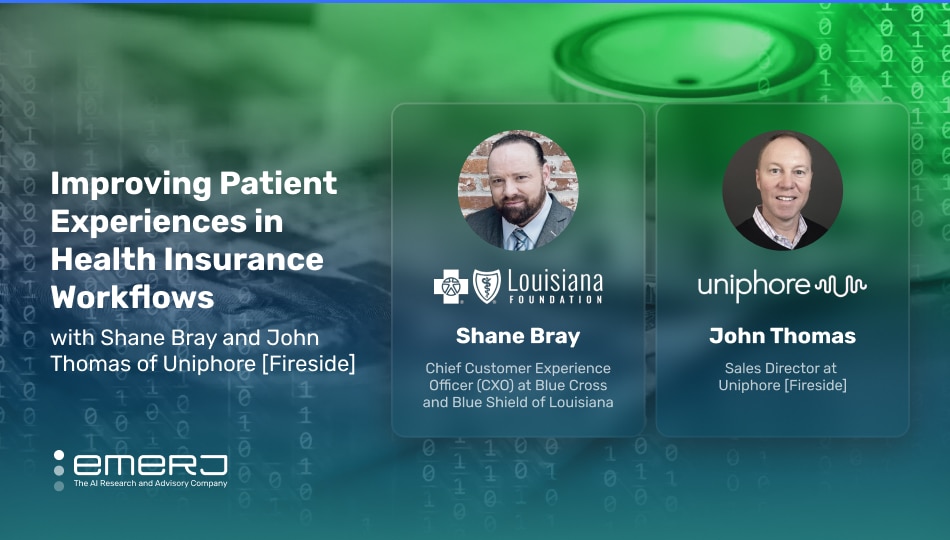
This interview analysis is sponsored by Uniphore and was written, edited and published in alignment with our Emerj sponsored content guidelines. Learn more about our thought leadership and content creation services on our Emerj Media Services page.
The convergence of healthcare and financial services presents a compelling opportunity for the integration of AI to elevate patient experiences and customer interactions in insurance workflows.
According to the National Library of Medicine, AI has numerous potential financial benefits in healthcare organizations, emphasizing its capacity to drive cost savings in call center operations, administrative processes, patient scheduling and supply chain management.
Emerj has reported extensively on the impact of AI – and in particular, new generative AI capabilities – on financial services over the last year, especially in call centers and other business areas involving direct management of customer relationships.
Yet in perhaps the most serious example of AI’s future impact on healthcare: foundational large language models like OpenAI’s Chat GPT-4 are now powerful enough to pass a medical exam. These models can now serve as the starting block to train ‘bespoke’ versions that are focused on more challenging, industry-specific and directly customer-facing tasks throughout healthcare organizations.
Emerj Senior Editor Matthew DeMello recently sat down with Shane Bray, Chief Customer Experience Officer (CXO) at Blue Cross and Blue Shield of Louisiana, and John Thomas, Sales Director at Uniphore, to discuss this convergence of technology throughout healthcare and financial services and how AI can enhance experiences for patients both as patients and insurance customers.
Blue Cross and Blue Shield of Louisiana is an independent licensee of the Blue Cross and Blue Shield Association and incorporated as Louisiana Health Service & Indemnity Company. Uniphore is an AI vendor specializing in integrating AI technologies to enhance customer experiences across different industries, utilizing generative-, knowledge- and emotion AI along with workflow automation.
This article analyzes their perspectives – coming from both the operations and systems sides of healthcare insurance delivery – and provides for executives the following critical insights from their conversation:
- Generative AI for emphasizing empathy with patient interactions: Improving outcomes by providing nuanced and empathetic responses to patient concerns through leveraging sensorial capabilities that closely examine patient behavior, such as motion detection.
- Balancing AI deployment in both patient and employee experiences: Keeping employees and their experiences in mind when deploying advanced AI systems to improve patient outcomes through streamlining tasks and minimizing redundancies.
Guest: Shane Bray, Chief Customer Experience Officer (CXO), Blue Cross and Blue Shield of Louisiana
Expertise: Customer experience, knowledge management
Brief Recognition: Bray reports to Blue Cross President and CEO Steven Udvarhelyi, MD, in his current role and is part of the Blue Cross Senior Management Team. Throughout his time at Blue Cross, he has developed a multi-year strategy and roadmap to improve customer interactions. Bray is also a United States Air Force veteran, where he served as a combat medic and clinical trauma nurse.
Guest: John Thomas, Sales Director, Uniphore
Expertise: Business development, Customer relationship management, Sales leadership
Brief Recognition: John Thomas is a seasoned sales professional currently serving as the Sales Director at Uniphore, based in Texas, USA. With a strong track record in new business and major account selling, he has demonstrated expertise in various industries, including BPO, eCommerce and utility/energy. He graduated from the University of North Texas in 1998.
Generative AI for Emphasizing Empathy with Patient Interactions
John outlines his approach to improving interactions and relationships within the healthcare ecosystem — whether between healthcare providers and patients, or financial institutions and clients. He acknowledges the importance of maintaining high-quality relationships and patient experiences while being fiscally responsible, considering the economic challenges many healthcare systems face.
He introduces the concept of leveraging AI advantages to achieve this delicate balance, emphasizing the technological potential to enhance patient experiences, satisfaction scores and ratings while reducing costs.
John also points out that new generative AI enhancements can bring a unique value proposition by guiding human agents to demonstrate greater empathy in patient interactions. He introduces blending AI capabilities, such as motion detection along with generative AI, to create more nuanced and flexible systems.
Unlike traditional conversational AI, generative AI can provide varied responses based on understanding the context and user requests, with a focus on conveying empathy and sympathy in its interactions.
Most importantly and often overlooked in these conversations, John then discusses the limitations and applications of AI, particularly in the context of diagnosis. He mentions that from a diagnosis perspective, AI may not be applicable in the contact center, where medical diagnoses typically do not occur.
However, the AI system can access specific information from throughout the organization and provide said data to customers in the contact center setting, where there may be connections to systems like Epic or other customer relationship management (CRM) platforms.
This information could include data that nursing contact center staff or specialists may be reviewing. In this case, AI’s role is not to directly make diagnoses but to make relevant information more easily accessible for the agents assisting on the phone, such as registered nurses (RNs) or other support personnel.
Shane goes on to explain that the AI can cross-reference information and, while it may not make direct recommendations, it can triangulate and highlight essential pieces of data.
Shane also discusses a broader perspective on healthcare, mainly focusing on social determinants of health. He highlights the complexity of human behavior in relation to healthcare appointments, noting that sometimes people miss appointments due to competing priorities in their lives.
He also brings attention to social determinants such as rural living or financial constraints, where individuals may struggle to access healthcare due to factors like transportation.
Shane concludes by emphasizing the evolving approach of innovative health systems and clinics that are expanding the scope of healthcare beyond the status quo. He suggests that the concept of care should extend to proactive considerations like how patients will reach their appointments or even how they’ll manage their health-related activities after leaving the hospital, such as dietary habits for those with diabetes.
Shane sees the potential for AI to play a catalyst role in this expanded, more forward-thinking scope of care, as he believes AI can help address challenges by identifying ancillary opportunities to the core healthcare process.
He points out that, as humans, we tend to define healthcare within specific limits, but AI in his view doesn’t carry the same mental constraints and can contribute to a more holistic and expansive approach to the Hippocratic oath.
Balancing AI Deployment in Both Patient and Employee Experiences
With regard to AI’s broader anticipated impact on healthcare, John discusses the importance of understanding the complexity of diagnoses and patient needs within the healthcare system.
He emphasizes the need for a comprehensive understanding of patients’ unique situations and the ability to analyze diverse datasets, including information from various communication channels such as email, portal chat, phone conversations and video interactions.
To focus these processes on the core mission of the healthcare enterprise, John focuses on offering tangible strategies for leveraging AI to analyze this data and extract valuable insights. The goal is to identify patterns, trends or information that may not have been initially apparent.
He highlights that the strength of AI in enhancing patient experiences through conversational contexts lies in its adaptability to understand different call types and the uniqueness of patient cases that may have yet to be previously identified. The adaptability of AI allows it to quickly respond to new or unexpected information, contributing to more effective decision-making.
John also stresses the concept of personalization in healthcare interactions, especially in areas like patient access or the digital front door. He explains that AI excels in uniquely addressing patients who may not fit typical demographic expectations.
Further, AI-enhanced systems can triangulate various pieces of data, find trends to pair with organizational indicators and adapt the enterprise’s approach to handling conversations and patient interactions in a highly personalized manner.
In response, Shane brings attention to a crucial aspect often overlooked in discussions about AI in healthcare: its impact on not just patients but the healthcare professionals who use it to help those patients.
He acknowledges that the conversation has mainly focused on how AI influences the patient experience and the end user’s interactions. However, he emphasizes the need to consider how AI affects the healthcare workforce itself, including nurses and physicians:
“Sure, we want to improve the patient experience. We want to improve the experience that our members have with the plan, but to do that, we have to improve our agents’ experience. And we have to improve the capabilities and the technologies in all of those redundant tasks that they have.
The more you look at AI as a comprehensive solution, from all facets of the problem, it can be a really powerful thing, but not just focusing on the consumer side. You know, those nurses and those doctors: they are people too, and they’ve got all sorts of things that they’ve got to manage.”
– Shane Bray, Chief Customer Experience Officer (CXO) at Blue Cross and Blue Shield of Louisiana
Using the example of a call center that he manages, Shane explains that improvements in customer experience and member interactions are linked to enhancing the work experience for agents.
By deploying AI to streamline and optimize the tasks performed by agents, redundant processes can be identified and minimized, leading to a more efficient and satisfying work environment for care providers. Shane argues that viewing AI as a comprehensive solution for expediting workflows for healthcare providers is an essential approach to improving outcomes for patients.







